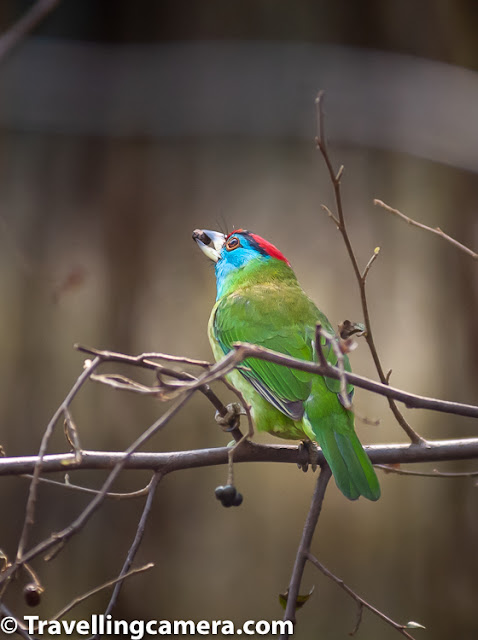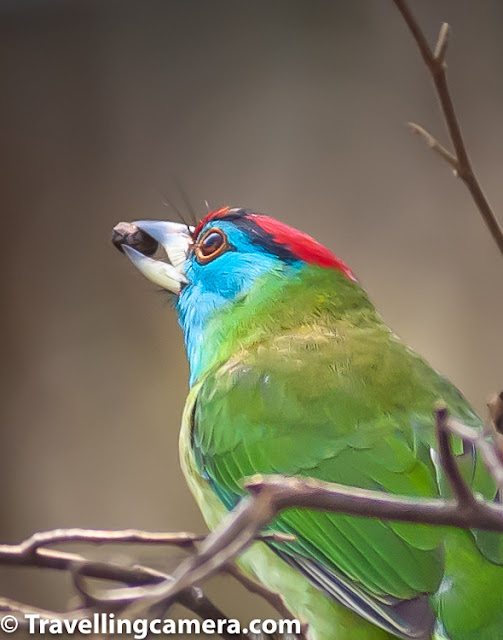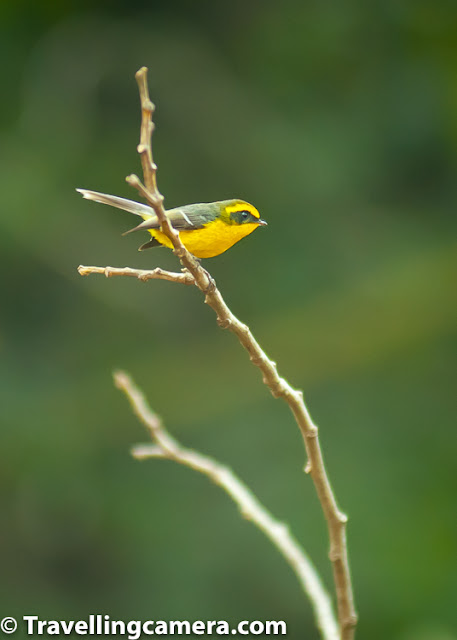 |
| Blue-throated Barbet |
Birds add a lot of charm to our visits to our hometown in Himachal Pradesh. In fact, one of the most exciting aspects is the sheer variety of birds that one can spot there, right from our terrace. The secret behind this is the little stream that flows right behind our house. A dense vegetation that comprises of various types of trees, vines, and shrubs. Apart from leafy trees that provide shade and nesting opportunities, there were fruit trees and vines that provide food. There are also several types of insects that attract flycatchers, thrushes etc. Some of the trees have been trimmed recently so the warblers were very few.
Related Blogpost - Winged Wonder of California - Birding tours around San Francisco Bay Area, CA |
| Blue-throated Barbet |
The Blue-throated Barbet made a reappearance this time. The Chayote vine that my father-in-law had planted has spread across the stream and the Barbets are apparently nesting there and feeding on the chayotes every day. We had to be patient as the Barbets preferred to stay hidden in the vegetation, but finally our patience yielded results and it struck some nice poses.
Related Blogpost - Bar Headed Goose flying near Pong Wetland in Kangra region of Himachal Pradesh, India
 |
| Blue-throated Barbet |
Throughout our stay the only activity we saw this bird do was eating. And it made absolutely zero noise. Another observation was that this was a really restless bird and wouldn't stay at a single place for more than a few seconds. It would keep hopping to higher branches till it got out of the range of our basic camera and then relax. It would keep sitting there for hours, out in full view, keeping absolutely still. But yes, just out of the range of our camera.
Related Blogpost - Tiny Darts of Color || Vibrant Birds of Darjeeling
 |
| Indian Robin |
The Indian Robin is a passerine bird that is widespread in the Indian subcontinent. The males of northern populations have a brown back, whereas those of the southern population are almost entirely black. They are commonly found in open scrub areas and often seen running along the ground or perching on low thorny shrubs and rocks. The long tail is usually held up to reveal the the chestnut undertail coverts.
Related Blogpost - A visit to Surajpur Birds Sanctuary - A Bird Sanctuary at Risk
 |
| Yellow-bellied Fairy Fantail |
It is a misnomer to refer to this bird as a Fantail because the DNA analysis has placed this bird closer to the family of fairy flycatchers. And if you happen to observe the bird in action you will definitely realize that it is a flycatcher. The way it perches is very similar to the white-browed fantail, but a fantail behaves in a very different way.
Related Blogpost - Songbirds at Bharatpur || The Constant Orchestra of Keoladeo National Park
 |
| White-browed Fantail |
The yellow-bellied fantail is actually a very cute little bird. It is tiny, only about 8cm long. It has a black eyeband, a bright yellow belly and dark brown / black upper parts. This is another quick bird that is not easy to capture in a camera. It took us quite a few tries and required a lot of patience to capture it on a camera.
 |
| Grey-hooded Warbler |
The White-browed Fantail, on the other hand, is almost 18cm long, more than double the size of the yellow-bellied fantail. This fan tail flits from branch to branch and is so called because it is often seen with its tail spread like a Japanese hand fan. This is an insectivorous bird.
 |
| Grey-hooded Warbler |
The grey-hooded warbler is a 10-12 cm long leaf warbler that has a sweet and cheerful call, which is music to one's ears. This little warbler eats everything from tiny spiders, catterpillars, insects, berries. It is found foraging for food in leafy branches.
Related Blogpost - The Winged Wonders of Pong Wetlands - by Vibha Malhotra, TOI
 |
| Grey-hooded Warbler |
The grey-hooded warbler has bright yellow underparts and yellow streaks on wings and tail. It has white and grey stripes on its head and grey shades on its neck and tips of the wing and the tail. It is a pretty little bird and is a joy to have around your home.
Related Blogpost - Elusive Songmakers of Dalhousie, Himachal || Birds of the Himalayas
 |
| Common Tailorbird |
Related Blogpost - The Winged Models || Birds of Badahin, Mandi, Himachal Pradesh
 |
| Grey Bushchat |
The Grey Bushchat is a small passerine bird that is often seen perched on high wires. The male of the species is easily identifiable because of its black eyeband and white belly. The female is rufous brown in color and with much lighter eyeband. It feeds mostly on small insects, grasshoppers, etc, and is also known to occasionally feed on seeds.
Related Blogpost - The Winged Models || Birds of Badahin, Mandi, Himachal Pradesh
 |
| Yellow-bellied Fairy Fantail |
The Grey Bushchat is found in the Himalayas, southern China, Taiwan, Nepal and mainland Southeast Asia. Its natural habitats are subtropical or tropical moist lowland forests and subtropical or tropical moist montane forests.
Related Blogpost - Incredible Birds of Costa Rica - part 4 || Flycatchers, Warblers, Solitaires, Jays, Egrets
 |
| Blue Whistling Thrush |
Related Blogpost - Birds of Ayuthhaya, Thailand
 |
| Great Barbet |
The Great Barbet made another appearance behind our home. It too was attracted by the ripe Lonku fruits that lay scattered near the stream that flows behind our home. This time we managed to capture it in our camera. The bird is much more beautiful in reality though. This is really the largest Barbet you can find, and it sports all the colors Barbets are famous for - a little bit of green, a bit of blue, some purple, orange, yellow and also red.
Related Blogpost - Our trip to the Keoladeo National Park || An Overview


.jpg)
Comments